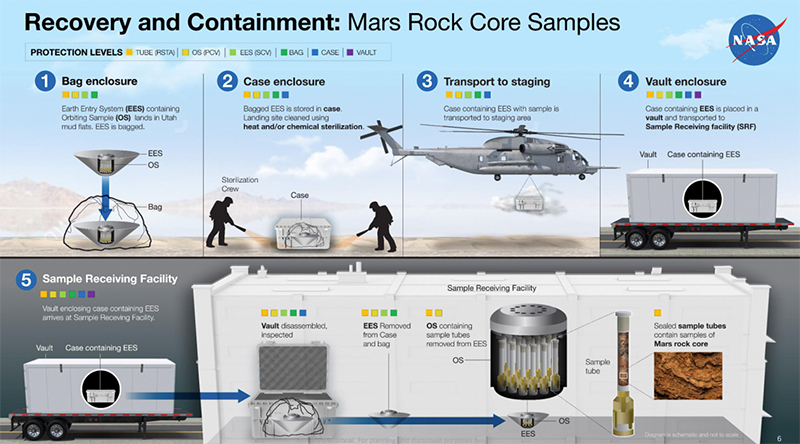4.1.3 Mars sample return
While most of the focus around planetary protection has been on the risks to Mars from terrestrial contamination, missions that might return to Earth from Mars carrying martian materials are already planned. Samples of rocks and soils are being collected by NASA’s Perseverance rover [Tip: hold Ctrl and click a link to open it in a new tab. (Hide tip)] (currently on Mars), stored there, and will be returned to Earth by a future mission, sometime in the 2030s. A sample return mission from Mars would be categorised as Category V ‘Restricted Earth return’.
To prepare for this eventuality, much effort has been put into understanding the harsh martian environment and its potential effect on life and its proliferation. In addition, to reduce the risk to Earth’s biosphere, the samples brought back to Earth would be stored, curated and analysed in a special facility (a Sample Receiving Facility), preventing any material from entering the outside world until it was proven to be safe. In Video 10, the rationale behind such a facility is explained and Figure 27 shows one proposed process by which samples returned from Mars would be delivered through the Earth’s atmosphere to the sample receiving facility.

Transcript: Video 10 Dr Francis McCubbin explains the importance of sample return planetary protection

At the Sample Receiving Facility, the samples would be placed in a cabinet to contain any potentially harmful life, whilst also ensuring that the samples are kept ultra-clean, so that terrestrial life doesn’t contaminate the samples (causing false negative results).
A false positive result is one that indicates the presence of something that is not actually there. In the search for life, contamination might suggest extraterrestrial life is present, but it is in fact from Earth.
A false negative result is one that indicates the absence of something, even though it is present. In the sample receiving facility, terrestrial contamination may be detected and identified but might mask the presence of extraterrestrial life.
These are good reasons for ensuring there is an understanding of potential contamination, but also for developing suitable facilities on Earth for returned samples.
A consortium in the UK (including The Open University) is developing a cabinet that can protect the samples and the Earth environment. The concept is called a ‘double walled isolator’, and it uses positive pressure as a barrier between the laboratory and the samples. That is, the pressure inside the cabinet is higher than around it, preventing anything from entering the chamber (Figure 28).

While the cabinet provides protection for returned samples, it still needs to be operated within a cleanroom environment. As has already been alluded to, cleanrooms are also critical environments for the building of spacecraft as part of contamination mitigation.
